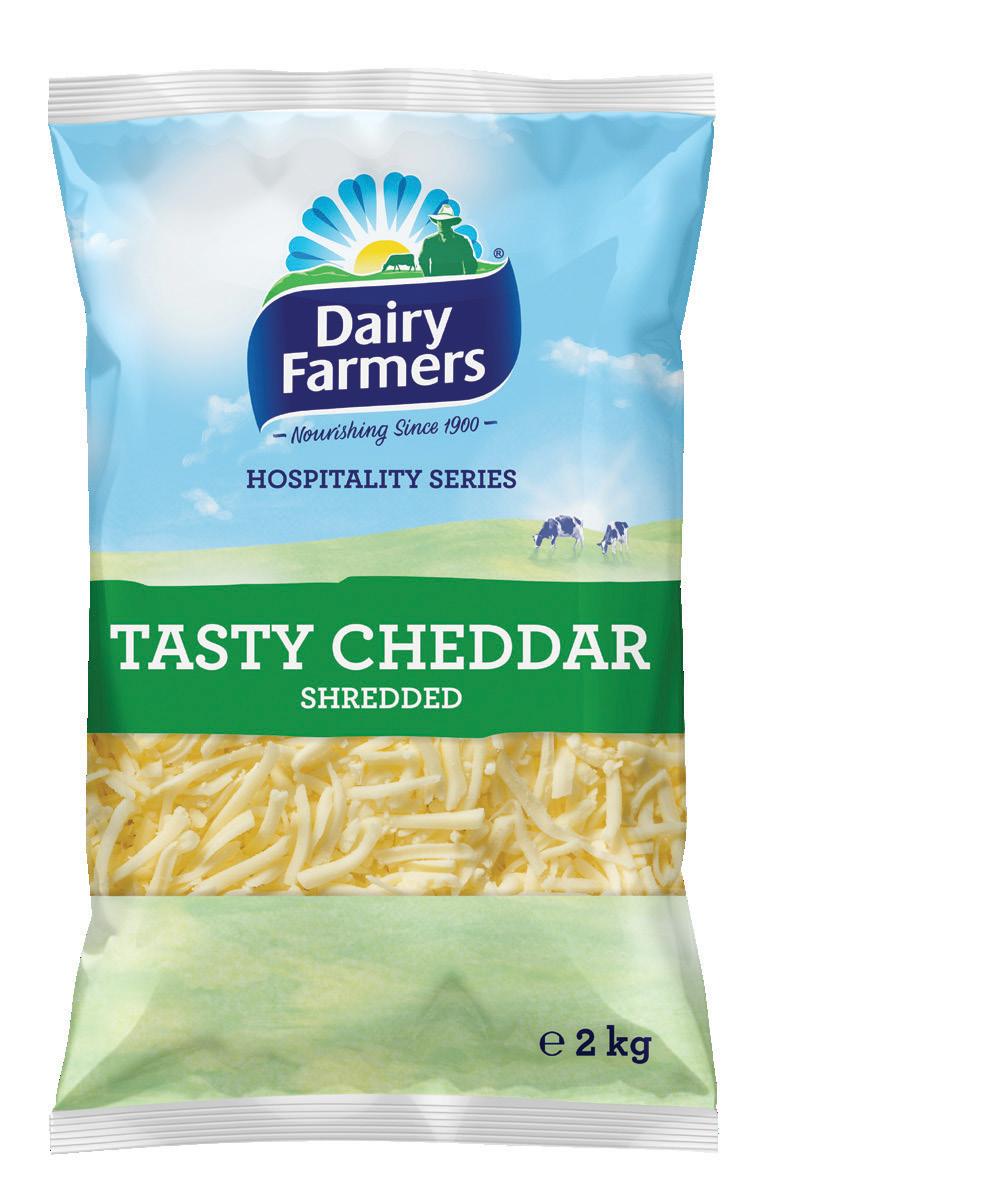















Make Maggi® Gluten Free Supreme Gravy Mix the star of your team, and treat your customers to full-bodied, beef-flavoured brilliance that just happens to be vegan.











8 // IN FOCUS
Gundagai Lamb has invested in technology that’s revolutionised its business.
12 // NEWS
The latest openings, books, events, and more.
14 // COLUMN
Four Pillars Co-Founder Matt Jones on the creation of the iconic brand.
18 // PRODUCE
Pumpkin seeds are not to be confused with pepitas.
20 // BAR CART
Thirst quenchers, slow sippers, and all things beverage related.
22 // DRINKS
Why summer is peak season for bar professionals.
26 // PROFILE
How Garima Arora ended up opening a two Michelin star restaurant in Thailand.
48 // EQUIPMENT
The humble potato masher.
50 // 5 MINUTES WITH… Africola’s Duncan Welgemoed
30 // 2025 TRENDS
What’s hot and what’s not in the food and beverage world.
34 // NESTLÉ GOLDEN CHEF’S HAT
The cooking competition is gearing up to celebrate its 60th anniversary.
44 // BUSINESS TIPS
Hospitality professionals share their intel.



JUST LIKE THAT, another year has flown by and our final issue is out in the world. It’s been an interesting 12 months for the industry, especially with the cost-of-living pressures many are facing. But if 2024 has shown us anything, it’s that the hospitality industry is nimble and agile. The top end of the dining sector has remained largely unaffected — the corporate long lunch lives on. But it’s been great to see many venues offering budget-friendly options to guests whether it’s in the form of a happy hour or a set menu priced under $50.
This issue, we cover the topic and more in the 2025 trends feature, which charts our predictions on what will be trending — and what won’t be — next year. In the spirit of the
PUBLISHER
Paul Wootton pwootton@intermedia.com.au
MANAGING EDITOR
Annabelle Cloros
T: 02 8586 6226 acloros@intermedia.com.au
JOURNALIST
Laura Box lbox@intermedia.com.au
festive season, we have 25 candid business tips from hospitality professionals located across the country as well as an interview with one of the most successful chefs in the world, Garima Arora. We’re absolutely thrilled to have her in the pages of Hospitality, and her profile is a fitting way to end a big year of content. While this is the last print issue for 2024, sign up to our digital newsletter over at hospitalitymagazine.com.au for the latest news stories and online exclusives. Thank you for your support and I wish you all a Happy New Year!
Until next time,
Annabelle Cloros Managing Editor
COMMERCIAL DIRECTORHOSPITALITY GROUP
Simon York T: 02 8586 6163 syork@intermedia.com.au
ART DIRECTOR Sanja Spuzanic sspuzanic@intermedia.com.au
PRODUCTION MANAGER
Jacqui Cooper jacqui@intermedia.com.au
CIRCULATIONS
To subscribe please call 1800 651 422. hospitalitymag azine.com.au facebook.com/ HospitalityMagazine twitter.com/Hospitalityed instagram.com/hospitalitymag



SUBSCRIPTION RATES Australia: 1 year (10 issues) = $99.00 (inc GST) 2 years (20 issues) = $158.40 (inc GST) – Save 20% 3 years (30 issues) = $207.90 (inc GST) – Save 30%
SUBSCRIPTION RATES
New Zealand: 1 year (10 issues) = $109.00 Asia/Pacific 1 year (10 issues) = $119.00
Rest of World: 1 year (10 issues) = $129.00
&







How a rural meat-processing business is giving lamb the Wagyu treatment.
WORDS Annabelle Cloros
100-PLUS YEARS IN Gundagai’s meat industry all started with a butchery apprenticeship. Will Barton’s grandfather Fred made a career choice in 1919, which resulted in shopfronts, the establishment of Gundagai Meat Processors in 1974, and now Gundagai Lamb — a gamechanger in the industry.
Australia has access to leading technology when it comes to meat
processing, but few proteins benefit from it, and none more so than beef. Barton wanted more for the lamb sector, which led to a major investment that changed the landscape for good. Hospitality speaks to the CEO about processing carcasses with state-of-the art technology and machinery, developing the GLQ scoring system, and providing invaluable data to farmers.
Gundagai Meat Processors made a decision to focus on lamb at the turn of the century, which came from an idea to do one thing only and do it well. “There was an opportunity to do lamb better,” says CEO Will Barton. “The lamb industry had not progressed in the same way beef had. 30 years ago, the beef industry went through a revolution where carcasses started to be graded and now it’s hard to get a bad steak in Australia because of that knowledge. For a long time, that grading technology was not available for lamb.”
But that all changed in 2020 when Barton connected with Remo Carbone from MEQ Probe, a company that creates data solutions to ‘optimise the global red meat industry’. “We put our heads together and decided to partner up to develop the technology,” says Barton. Things moved quickly. MEQ Probe created machine learning based on its access to Gundagai Lamb’s meat-processing facility. The tech business was so invested in the potential of its work that it even moved its head office to Gundagai. “It came from a goal to further the industry, improve, and take advantage of technology that the rest of the industry didn’t seem to be getting a hold of,” says Barton.
So how does it all work and what exactly is this technology? When lambs come into the facility, the carcasses have already been prepared to Aus-Meat standards. Each loin is probed to determine the level of marbling before being weighed and put through a dual-energy X-ray machine “that is configured for carcasses to move through continually”, says Barton. “We know the percentage of the lean meat yield from the X-ray technology.” A meat inspector then looks at the offals and inspects the carcasses to identify any animal health issues.
Each carcass is scored according to the GLQ measuring system, with a score of five and above attracting a bonus of 80 cents per kilogram. A five-plus carcass has a higher lean meat yield with no excess fat and no waste as well as higher intramuscular fat aka marbling. “It is based on a proprietary algorithm we have developed,” says Barton.
“Every product has been measured objectively using science – not with one eye closed and a thumb in the air.”
– Will Barton
“It encourages above average marbling without over-fattening. Every product has been measured objectively using science — not with one eye closed and a thumb in the air.”
Gundagai Lamb processes lambs from around 240 suppliers. “Every year we set a target to get more and more local lambs,” says Barton. Last year, 50 per cent of processed lambs were raised within 100km of Gundagai and 76 per cent within 200km — the rest came from within 400km. The farmer demand for data is incredibly high, with one producer driving lambs all the way from South Australia to be processed at the facility. “When you send a lamb to a processor, they tell you how heavy the carcass was,” says Barton. “We tell them that, but then we also tell them the percentage of lean meat yield, the level of marbling, and if the animal had any health issues or carcass defects.”
The feedback is unique, and most importantly, detailed. Farmers can log into an interactive portal after 5pm each day and access information about the carcasses that were processed just hours before. The constant feed of information allows farmers to identify any issues in their practices from feed quantity to the performance of certain breeds, most of which are Merino or Merino crosses. “They can see whether their decisions around genetics have paid off and if they have met the nutritional needs of the animal,” says Barton. “They also see how many lambs made the bonus category and can run comparisons against other lots they have sent in. This information alone








The facility processes lambs from small and large farmers

Grill’d uses coarsely ground lamb shoulder in its lamb burgers Merino and Merino crosses are the most common breeds processed

Producers receive an 80 cent per kg bonus for carcasses that score 5 and above
is motivation for farmers who are as passionate as we are.”
Along with consistency and reliability of product, sustainability is another benefit that has come from the implementation of the meat-processing technology.
Barton says it takes six times the amount of grass to create a kilogram of fat as it does a kilogram of meat. Once a lamb grows to the point where it is ready to be slaughtered, it will still consume grass, but only put on fat, which is removed during processing. “Being able to tell a farmer when an animal is getting too fat is critical for sustainability,” says Barton. “Farmers can then reduce the amount of grass which can instead be used to grow more lambs.”
Gundagai Lamb supplies a range of leading chefs across the country include Clare Smyth from Oncore in Sydney and Jason Staudt from Stokehouse in Melbourne, as well as restaurants abroad. The products are more expensive than others on the market, but Barton says it all boils down to consistency. “When you buy a box of lamb from any other brand, it will be a mix of good and bad because they can’t measure the meat yield,” he says. “It could have low marbling; some could be fatty… so the pressure is on the chef to make sure they prepare the cuts as carefully as possible to overcome


the variability in the raw material. But if you remove those variabilities, a chef can prepare the product with much more confidence.”
Stokehouse Executive Chef Jason Staudt previously steered away from putting lamb on event menus due to the unreliability of the protein, but that all changed when he began working with Gundagai Lamb. “Now he puts our lamb on at the Australian Open because he knows its repeatable,” says Barton. “It’s about eating high quality as much as it is about consistency, which is what foodservice loves.”
But the product isn’t just for the topend of the dining sector. There are a

wide variety of cuts available beyond the highly coveted rack that perform just as well. Barton mentions a rib set as well as leg primals and shoulder meat as some of the most underrated options. “If you get a GLQ5+ rib set or rib plate, the product is amazing,” he says. “The rib set has a level of intramuscular fat. The knuckle or the round are good as well. All the eating quality testing has been done in Australia. If a chef is innovative and wants to try something new, there are many cuts beyond your typical finedining options.”
It’s been just four years since Gundagai Lamb implemented its new technology, and the business has been slowly but surely growing ever since. Recognition by a chef like Clare Smyth is not to be taken lightly and neither is the feedback the data provides to the hundreds of lamb farmers the business works with.
Barton set out to progress the lamb sector, and the proof is in the number of GLQ5+ carcasses now coming through the facility, which means the processes are working from the top down. Farmers have taken the feedback on board and changed their own systems, but the goal remains the same — reliability. “We aren’t trying to be the Wagyu of lamb, which is a tag we often get because most consumers understand it and know it,” says Barton. “We are just trying to be above average and consistent.” ■
Ready-to-use
Easy ambient application
Smooth and reflective finish
Customise with flavour and colour






READY-TO-USE MIRROR GLAZES NEUTRAL MIRROR GLAZE
Transparent, glossy glaze that enhances with a shiny finish.
CODE SIZE QTY/CTN
1-96-000579 1 kg 6 GLAMOUR MIRROR GLAZE
Silver translucent glaze containing shimmery edible glitter.
CODE SIZE QTY/CTN 1-96-000581 1 kg 6

MIRROR GLAZE
Opaque pure white glaze producing a solid coating.

The latest openings, books, events, and more.
WORDS Laura Box

Chris Lucas has assembled a dream team to open the doors of Maison Bâtard in Melbourne after almost a decade of planning. The French dining destination covers four floors and is located inside an early 20th century building on Bourke Street. Patrons can expect a two-floor linchpin restaurant, a late-night basement diner, and a rooftop terrace. The opening team includes Executive Chef Adam Sanderson (Fat Duck, Noma), Lucas Restaurants Head of Culinary Damian Snell, Head Pastry Chef Michaela Kang (Grill Americano), and Head of Wine Loic Avril. maisonbatard.com.au
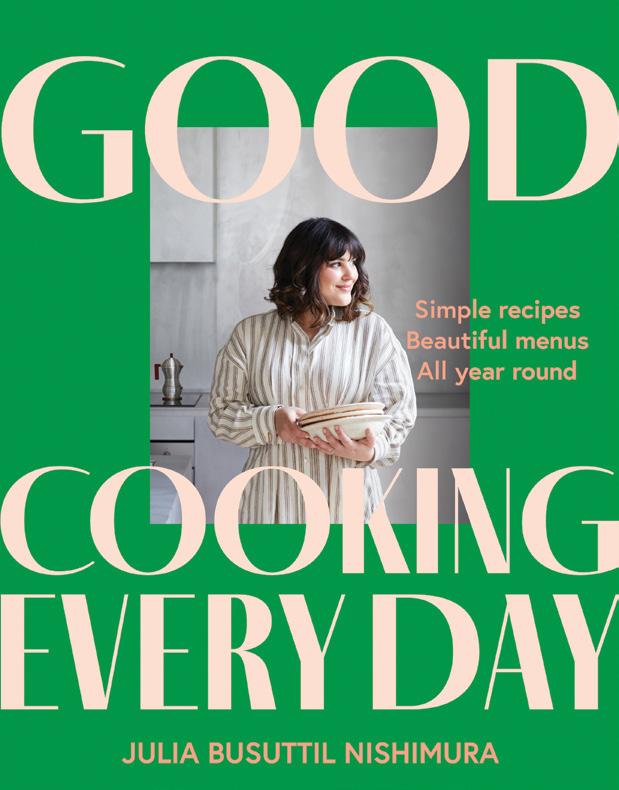

Chef Dan Hunter is collaborating with Danielle Alvarez to headline an exclusive dinner series at the Sydney Opera House, which will see the three-hatted restaurant come to the city for the first time. Running from 17–20 January, the ticketed event will see the duo deliver a six-course menu with an optional wine pairing curated by Handpicked Wines. “Our menu will be a tribute to beautiful local produce, our Australian landscape, and the people who grow our food and care for our land,” says Alvarez. trippaswhitegroup.com.au
Julia Busuttil Nishimura
Pan Macmillan ; $44.99
Beloved cook, author, and food personality Julia Busuttil Nishimura has released her newest cookbook, adding to her run of best-sellers. Good Cooking Every Day is about simple cooking and creating memorable meals. Standout recipes include a one-tray vinegar maple chicken; a rustic and hearty tomato tart with flaky pastry; and madeleines rolled in orange sugar. panmacmillan.com.au


Dave Pynt with Max Veenhuyzen Fool Agency ; $95 SGD
Renowned Chef Dave Pynt of Singapore’s celebrated BBQ restaurant Burnt Ends explores cooking with fire, coals, and smoke. His first-person narrative divulges the innovative techniques, bold flavours, inspiration, and creative style behind his signature dishes. “Modern barbecue means anything goes — no tradition, no history, no borders,” he says. “We cook whatever we want as long as it’s tasty.” burtends.com.sg
Known for its large, clear crystals, salt experts Olsson’s have released a new collection of salt storage pots. The Salt Keeper ($23.50) is designed to keep any salt fresh. Its low, wide design perfectly fits the rim of cocktail glasses, making it a no-brainer for drinks enthusiasts. The Pinch Pot ($18) is designed to store cooking salt and flakes and comes with a bamboo spoon for easy access during cooking. Both pots feature Olsson’s signature stripes and are available at specialty stores, supermarkets, and online. olssons.com.au


Specialty poultry producer Aurum Poultry Co. and Melbourne charcuterie connoisseurs City Larder have teamed up to create three gourmet products. Each creation features Aurum’s signature Fook Wong cockerel from Victoria. Products include cockerel liver pâté with ginger and garlic; a cockerel, Moorabool Valley corn-fed duck, and chive terrine; and a cockerel double stock, which has been slow cooked for nine hours without preservatives, additives, or colours.
Photography by Bonnie Savage

Dan Keeling
Hardie Grant ; $60
London-based writer, wine merchant, and restaurateur Dan Keeling is promising to take the guesswork out of great wines. Named after the elusive Holy Grail of premium French wines, Who’s Afraid of Romanée-Conti? covers the cosmos of vinos from the lavish and rare to the cheap and cheerful. Keeling offers insights into wine culture and winemaking as well as personal recommendations across the vigneron spectrum. hardiegrant.com

Co-Founder Matt Jones on the development process of Four Pillars.
THE IRONY OF how we went about crafting Four Pillars is that, while we have always been about the gin first and foremost, we were actually developing our initial brand designs and packaging in parallel with Cam developing the gin. So, we were designing an idea of what we wanted the Four Pillars brand to represent even though we didn’t have the final gin recipe yet.
My brand education had begun years earlier. Brands, the way I see it, do not exist. Real things exist — banks, airlines, trainers, gins, cities, celebrities, political parties — and we all have feelings about these things. We can rationalise these feelings, but they are not in
themselves rational. Brand is just a word we use to describe the sum total of these feelings, these biases, towards a business.
When enough people have the same strong, positive feelings and biases towards a business, you’ve got a strong brand on your hands.
That’s all fine in theory, but here I was facing the reality of my first opportunity to help hardwire bias and emotion into my own business. For now, the remit was strictly design and storytelling.
We needed a bottle, and we all agreed that you only got one chance to be original, so we wanted a bottle that was custom and unique to our business. We needed a label to put on
the bottle, and that meant we needed a name to put on the label, plus a story to go on the side of the label. And soon, we would need the beginnings of a playbook to help us make other decisions, from designing our six-pack cases to thinking about our website.
First up was the bottle. Along with selecting our still (we named her Wilma after Cam’s late mum) and our gin botanicals (a work in progress as we awaited Wilma’s arrival), choosing a bottle felt like the next most substantial decision we would make. The bottle was literally how people (both bartenders and drinkers) would pick up and hold our brand. If it didn’t feel right in
their hands, the gin might never make it to their mouths.
We talked a lot about what kind of brand we wanted to be.
At the time, there were lots of new gin brands being launched overseas (the Australian craft gin boom was still to come) and some were leaning into their newness with radically modern bottles. We explored options for a bottle shape that would feel really disruptive, but we feared that something too ‘2013’ could start to feel tired within a few years. That helped us realise that a timeless sense of quality was a critical part of the brand we wanted to create.
Stu led the charge with bartenders, peppering them
with questions about bottles they liked or didn’t like and showing them early mock-ups of our proposed bottle. We learned that a shorter bottle was favoured (more stable and hefty in the hand), but not too wide, so even someone with smaller hands could comfortably pick it up and pour with one hand. And the neck should be long enough to make it easy to pour a shot without dribbling at the end (something multiple bartenders told us frustrated them about the very stubby neck on the Hendrick’s bottle).
In parallel with this work, our design agency partners started working on the label design, showing us things that were both super contemporary and more traditional. And, again, we aimed to strike that balance of timeless, crafted luxury — not too modern or sterile, but also not too retro, fancy or projecting fake heritage. We wanted something clearly premium, but also restrained and not over the top.
Lastly, we needed a name to put on all this design work. Over my years as a brand strategist and consultant, naming has always been my least favourite part of the job. In short, there are no good names, but there are bad ones.
So many great businesses have names that started out clunky like ‘Facebook’ (a compound name, originally prefaced with a clumsy ‘The’), a bit random like ‘Google’ (a misspelling of a very big number), rather obscure like ‘Tesla’ (a dead, famousish scientist) or, in the case of the Australian unicorn Canva, needing a full rethink (Canva was a French-inspired pivot from its previous, and objectively terrible, name Canvas Chef). In all cases, the
We aimed to strike that balance of timeless, crafted luxury… We wanted something clearly premium, but also restrained and not over the top.
key was not the name, but the meaning built into the name over time.
The not terrible name we came up with was ‘Four Pillars’. What does it mean? Well, it depends on who you ask (there’s a non-sanctioned and inappropriate version Stu is liable to tell after a few Negronis). The official story is that ‘Four Pillars’ refers to our belief in the need to do a few things to an exceptional standard. It’s a belief in focus, excellence and simplicity, like the world’s greatest cocktail, the Negroni (equal parts gin, Campari, sweet vermouth and good ice). We added the word ‘gin’ to the end, making the official brand name Four Pillars Gin, emphasising our absolute focus on the craft of making gin and only gin.
The last piece of the brand puzzle was to agree on colours. Gin was dominated by blues (Bombay Sapphire), greens (Tanqueray) and reds (Gordon’s, Beefeater). The outlier was Hendrick’s with its almost medicinal dark black bottle. As

we were looking to compete with Hendrick’s at the top end of the price bracket (over AU$70 a bottle), we wanted to pick colours that communicated status, premium and (again) timelessness. The end result was our iconic black label with copper foil.
I’m so glad we held our nerve on all those decisions, from sticking with the black label (despite some people saying that gin was a summer drink and black was too dark, heavy and wintery) to sticking with the name Four Pillars (despite someone warning us that the number four was unlucky in Chinese) to making the big investment to have a custommoulded bottle from the outset (despite the minimal order soaking up far too much of our limited cash to purchase glass we wouldn’t need for ages).
Because the truth is that, while so much about our brand has evolved and grown since those initial design explorations in 2013, our core Rare Dry Gin bottle has remained broadly untouched and already feels like an icon on the world gin scene. ■






























































































































15g of pumpkin seeds provide an adult’s daily intake of magnesium and zinc

Dark green in colour
Harvested in autumn
Can be eaten fresh or pressed to make an oil
Come from the Styrian pumpkin
Not widely produced on a commercial level in Australia
The dark green seeds are found in just one type of pumpkin.
WORDS Lucy Allon and Tawnya Bahr
Origins
Did you know that pumpkin seeds and pepitas are not the same? While both are harvested from pumpkins, the two differ in structure, flavour, nutrient properties, and culinary applications.
Pumpkin seeds are known for their nutty flavour and nutritional profile. They come in two forms: those with a hard white shell and a smaller green pepita inside and those without a shell, which are larger and darker. The latter, grown without a husk, is the true pumpkin seed.
In Australia, husk-less pumpkin seeds are not widely produced on a commercial scale, with most products sold in small quantities. Pepo Farms is one of the main producers
of the seeds and is located in northeast Victoria, a region that has an ideal climate for growing. The company supplies foodservice with pumpkin seeds as well as other related products.
Unlike pepitas, which are extracted from the flesh of standard pumpkins, pumpkin seeds are found in a specific variety known as the Styrian (Cucurbita pepo var. styriaca ) pumpkin. The pumpkins yield larger seeds that are richer in oil and packed with nutrients including magnesium and zinc.
In Australia, the seeds are harvested during autumn, with the peak season running from February to May. The seeds are carefully harvested and dried to preserve their
natural freshness, resulting in a product that boasts exceptional flavour and nutritional value.
Pumpkin seeds bring versatility to menus, with their robust, nutty flavour complementing both sweet and savoury dishes. Roast them for a crunchy topping on salads or soups, grind them into flour for gluten-free baking or use pumpkin seed oil for dressings and marinades.
In Slovenia, a traditional way to end a meal is by drizzling pumpkin seed oil over vanilla ice cream. Whether used whole or as an oil, the culinary appeal and exceptional nutritional value of pumpkin seeds makes them a standout ingredient. ■

success of your establishment are too important to trust to any cooking oil.
For over 25 years, Formula 40, our flagship frying oil has built a reputation on consistent frying quality oil, which is why Formula 40 is the preferred brand of oil for chefs who understand the value of a good reputation.
Formula 40 is a uniquely formulated oil:
• Ideal for heavy-duty deep frying.
• It has a thicker, robust base ensuring a longer fry life and superior drain-off.
• A neutral oil taste helps retain food's natural flavour.
• It’s the frying oil of choice for the William Angliss Institute, the specialist training provider of tourism, hospitality and events industries.




Formula 40 is vegan and Halal certified and available in a 20L tin or in a lighter OH&S friendly 15 litre bag-in-box, which is a fully recyclable carton.
To order Formula 40 contact your local distributor For further oil advice or technical support contact Peerless Foods on 1800 986 499 or go to: peerlessfoodservice.com.au / peerlessfoodservice
Thirst quenchers, slow sippers, and all things beverage related.
EDITED BY Annabelle Cloros
The iconic Spanish beverage has been given an Aussie twist by Gria, a new wine brand from The Cocoa Group. The wine spritzes are available in red and white, with both options featuring Victorian wines fused with different fruits and spices. The white variety has citrus notes of orange, lemon, and lime with a hint of ginger, while the red has a heavier body accented by warm spices, blood orange, and cherry brandy. Gria is available at independent retailers for $25. griaspritz.com.au

Lark has released its annual limited-edition Christmas Cask. The single-malt whisky was aged in Frogmore Creek red wine barrels initially used by Hobart pâtisserie Jean-Pascal to hold and ferment excess fruit mince pie jus. Master Blender Chris Thomson then matured the Cambridge Distillery single-malt whisky in sherry and port casks, resulting in a complex dram with notes of orange blossom, honey-glazed walnuts, fresh custard, and toffee apples. Each bottle is packaged in a gift box featuring artwork from Australian-Filipino artist Victoria Leonisa Garcia. Available for $250 from Lark retail partners and larkdistillery.com


The Backpack West Coast IPA is a collaborative beer between Stone & Wood and Mountain Culture. The beer features American and Australian hops of Idaho, Amarillo, and Galaxy and has notes of mango, citrus, and stone fruit. The beer itself is a more classic style compared to the original brew, even though it has the same hops. “It’s super balanced and crisp, perfect for summer,” says DJ McCready, head brewer of Mountain Culture. The beer sits at 6.2 per cent ABV and is available from leading liquor retailers for $80 a carton. stoneandwood.com.au

’Tis the season to go all out, and Chandon has come to the party with the release of seasonal magnums. 1.5-litre bottles of Garden Spritz ($85), Vintage Brut 2017 ($110), and Vintage Brut Rosé 2016 ($110) are available for a limited time, and are the ideal beverages for holiday parties and summer gettogethers. Our pick? The classic Vintage Brut. It’s made from grapes harvested between early February to late March, which spend a minimum of two years on yeast lees. The final product is a sparkling wine with lime and green apple notes on the palate followed by hazelnut praline and fresh dough. chandon.com.au
The historic Château d’Estoublon estate in the heart of Provence is revered for its wines, and now there is a new Rosé collection from the house to enjoy. Wine figure Carla Bruni has worked on the range alongside the estate’s Technical Director Victor Joyeux since 2020 to produce the range which covers Roseblood Rosé ($50) and 1489 Roseblood ($100). The signature Rosé has notes of wild berries, white flowers, and citrus achieved by a blend of Provence Grenache, Cinsault, Syrah, and Rolle. 1489 is suitable for ageing, and has a floral nose with notes of fresh plum and berlingots. Distributed by House of Fine Wine. hofw.com.au





Seasonal cocktails are fuelled by innovative ideas.
WORDS Laura Box
PHOTOGRAPHY Anson Smart and Prefecture 48; Ryan Ng for Bar Love
“FLORALS FOR SPRING?
Groundbreaking”. The iconic line delivered by Meryl Streep in The Devil Wears Prada is hard to forget, and it’s one that’s tempting to replicate when it comes to summer cocktail lists: “Aperol spritz and Mojitos? Groundbreaking.”
While the classics are classics for good reason — for one, they sell themselves — it can be easy to fall back on go-to formats and forgo the innovation that leads to unique drinks and keeps customers coming back.
Hospitality chats with some of the country’s top bartenders about the summer drinks that are keeping their seasonal cocktail lists fresh, exciting, and inviting.
At Bar Love in Perth, Co-Owners Pippa Canavan and Murray Walsh may have found the formula for a perfect summer drink: “Very refreshing and a bit silly,” says
Canavan, “but complex enough to keep people coming back,” adds Walsh. The sentiment describes the duo’s Melon Baller cocktail, and it’s also not a bad description for the bar itself.
The ’70s inspired, retro-style venue opened on the intersection of Brisbane and William streets in October. As promised by the gold-emblazoned window signage, the bar is serving up cold drinks, warm service, and hot bartenders. The quirky fit out features a brightly coloured, vintage aesthetic, complete with a pink and white checkerboard bar, a smattering of bric-abrac, and velvet love seats.
The duo has accumulated a raft of accolades between them. Canavan won Host of the Year 2023 at the Bartender Magazine Bar Awards, was named Bartender of the Year 2023 at the WA Bar Awards, and featured in The Top 100 Most Influential and Australia’s Top 25 Bartenders lists. Meanwhile, Diageo’s World Class has listed Walsh as one of the Top 100 Australian Bartenders three times.
Canavan concocted the Melon Baller as part of Perfect Blend, a competition run by The Blend. While Canavan didn’t walk away with the top prize, winner Jac
Landmark is part of the Bar Love team. The drink is the “summeriest” on the menu and is a take on the Sgroppino — a refreshing Italian cocktail that combines prosecco, vodka, and lemon sorbet. The Melon Baller has a base of Midori and a hint of dry vermouth. The bartender blends honeydew melon and then freezes it overnight. The frozen melon cubes are then “zhooshed” in a blender with lemon juice, fresh eucalyptus syrup, and the spirits before being topped up with a little bit of soda water for fizz. “I tried to add other melon elements and green, bright refreshing flavours to push those aspects of the drink,” says Canavan. “We add a melon ball garnish which has been pickled in a sweet, light, and fresh brine. I wanted to lean into the fun, silly disco aspect of Midori.” Fittingly, it is served in a highball glass. “This one’s been going well recently. It’s bright green.”
“And super fun,” adds Walsh.
The drink’s success has turned out to be “a bit annoying because it’s a blended drink which is more annoying to make during service,” laughs Canavan. “But we knew what we were getting ourselves into.”
Another drink gaining traction at Bar Love is the Peaches and Cream Negroni, which Canavan describes as “a lighter, easier, and slightly sweeter gateway Negroni”. The playful peachcoloured take on the classic is served in a pinktinted Old Fashioned glass. It’s garnished with a white chocolate disk that has frozen polka dots of puréed tinned peaches on top.
“It’s basically a milk punch Negroni, but we add in a little bit of peach syrup as well,” says the bartender. “We use equal parts gin, Rosso Antico vermouth, Select Aperitivo, and peach syrup. We add a little bit of lactic acid to bump up the acid and then we punch it using buttermilk.”
The milk punching process is what allows the cocktail to achieve its “gateway Negroni” status. It involves adding lactic acid to the spirits, before pouring the acidified cocktail into buttermilk to curdle it. The curds are then removed using chef’s oil filters, which helps eliminate the bitter flavours and tannins. The final product has a creamy, buttery texture without the dairy solids, making for a lighter, easy-going cocktail.
“Seasoned Negroni drinkers still like it, but people see the colour and go, ‘Oh what’s that?
I’ll have one of those’,” says Canavan.
Bar Love has achieved a difficult feat that can be likened to the balance found in the Peaches and Cream Negroni: creating a menu that intrigues cocktail and spirits enthusiasts while still being fun and approachable enough for the general public.
Walsh says the split between cocktail connoisseurs and general patrons seems to be equal. “We have people who come here for the drinks, and I think we have people who come here for the atmosphere or the service,” he says.
“It’s always been part of what we have done; we created a space that should be inclusive for everyone. And that comes from all angles, whether you’re there to drink beer or cocktails or whether you’re coming in because this feels like safe space for you. We like making cocktails and we think we do it well, but we’re not necessarily forcing them down people’s throats.”
On the other side of the country, and on a much larger scale, is Prefecture 48. The sixvenue Japanese precinct recently opened in Sydney’s CBD, proffering an all-star team from Garaku Head Chef Derek Kim (former Tetsuya’s executive head chef) to Five Head Chef Hiroshi Manaka, who refined his skills at Michelinstarred restaurants across Europe.
Down the venue’s historic cobblestone alley and across the main courtyard, you’ll find Whiskey Thief. The bar has been decked out with fabric wall panels by Japanese tattoo artist Chris Horigo — it also has a menu designed by the acclaimed Maybe Sammy team.
Founded in 2019, Azabu Group has established itself as a curator of memorable gastronomic experiences driven by a combination of art, exceptional service, and a few unique surprises along the way. Maybe Sammy Co-Founder Stefano Catino says The Maybe Group’s goals aligned with Azabu’s vision

“Seasoned Negroni drinkers still like it, but people see the colour and go, ‘Oh what’s that? I’ll have one of those’.”
– Pippa Canavan




for Prefecture 48. “We liked the concept right away because they had a story to tell,” he says. “There is a lot of art and a lot of ideas in the venue, and we found ourselves fitting in.”
The parallels extended between Prefecture 48’s design and Maybe Sammy’s tenets, according to Catino. “We always think it should be seasonal. Each of the art panels in Whiskey Thief represent a season, so we want the cocktails to be seasonal, too.”
Whiskey Thief’s cocktails provide something for everyone — options that appeal to the daring and adventurous (like the Golden Origami, a gin fizz infused with earl grey and garnished with a golden origami biscuit), to
the more well-known classics such as the Margarita.
But even the classics have a unique Maybe spin on them; the Mandarin Kosho Margarita isn’t your typical lime juice/tequila/Cointreau affair. “We do a mix of tequila and a little plum distillate which is a bit weird — it gives the drink a smoky flavour,” says Catino. “We also use a bit of kosho and top it up with white sesame ice cream.” Kosho is a Japanese condiment made from fermented yuzu, chilli, and salt. It has a distinctly spicy and tangy flavour profile, which gives the cocktail a unique kick akin to a spicy Margarita. The cocktail is served in a ceramic glass with ice cream on the side. “It’s been one of the

“Each of the art panels in Whiskey Thief represent a season, so we want the cocktails to be seasonal, too.” – Stefano Catino
most popular drinks because Margaritas have been popular lately — especially in summer,” says Catino.
Another summer sip “named after an area in Japan with blue water and tropical beaches — it almost looks like it could be in Australia,” is the Okinawa Sling. “It has rum and pisco, a little bit of grape, and lemongrass,” says Catino. “We top it up with lychee and calamansi juice. The Minister of Okinawa was in the venue on the opening night, and he was very excited to see it on the menu.”
The drink is garnished with bubble tea pearls.
While there’s a strong case to keep classics on summer cocktail menus, the takeaway for creating experimental summer sips is simple: keep it fresh, keep it seasonal, and most importantly, keep it fun. ■





GARIMA ARORA’S CULINARY journey started with a hotpot. It was the dish that unlocked her love of food and cooking after she recreated it for her family upon her return from a trip to Singapore. The power of the hotpot was so great that she traded her life in Mumbai and career in journalism for an enrollment at Le Cordon Bleu in Paris. Arora went on to secure a commis chef role at Gordon Ramsay’s Verre in Dubai before working at Noma alongside René Redzepi for three years.
After cooking abroad for so long, the call of home was ringing loud and clear. What was meant to be a quick stop in Bangkok turned into another life-altering moment, with the chef realising the connection between her birth country and the country that was about to become her new home.
Hospitality speaks to Arora about the progression of Indian cuisine, balancing work with family, and why she didn’t choose Thailand — it chose her.
Garima Arora’s name is synonymous with culinary excellence. She is the first female Indian chef to receive two Michelin stars, was voted Asia’s Best Female Chef in 2019, and is the first female
judge on MasterChef India. Her restaurant Gaa is currently ranked no.33 on Asia’s 50 Best Restaurants list. She is the founder of Food Forward India and a supporter of the Chef Cares program, an initiative that offers culinary education to disadvantaged children. She’s also a mother.
But before all the accolades started flowing in, Arora made a pivotal decision. “When I first moved to Thailand, it was on a temporary basis,” says the chef. “I was supposed to be in the city for three months and then move to Mumbai — that never happened. One thing led to another, and I was approached by a group of investors who offered me the chance to create and run my own restaurant. The rest is history.”
The opportunity to open and front a restaurant of your own is the goal for many chefs. Gaa was always going to be something special as it is rooted in an idea that had yet to be seen in the culinary world. Fostering the links between Thailand and India is not only the backbone of Gaa, but the reason why Arora decided to remain in Thailand. “What solidified my decision to stay back was the connection India and Thailand share,” she says. “This is something nobody talks about or something I had


“I had to reiterate that curries and naan are not Indian food, but a colonised version of Indian food.” – Garima Arora
never heard about or thought of before. There are connections between the people, language, mythology, gods, food, and culture. Everything is so interconnected and intertwined, but somehow was never spoken of. The more time I spent here and got to know the people and made some friends, I realised Bangkok could be a great backdrop to explore modern Indian cooking.”
Gaa opened inside a traditional Thai house in 2017 — a milestone Arora names as the most noteworthy of her career, an achievement that surpasses categorical accolades, though she is of course proud of every award. “That was one of my biggest achievements and dreams to have opened a restaurant,” she says. “It was a dream come true. I never thought I would end up in Bangkok opening a restaurant here. But you know, sometimes life has its own way of playing out, and I’m glad I’ve landed here.”
The average diner’s knowledge and understanding of Indian cuisine has changed considerably over the past seven years, which can be attributed to several factors. People are generally more well-travelled; they also have an interest in discovering different cuisines. But it hasn’t always been this way. “When I started with Gaa, we opened as an Indian restaurant,” says Arora. “People came in expecting curries and naan. I had to reiterate that curries and naan are not Indian food, but a colonised version of Indian food that has been exported in the name of Indian cuisine for the longest time. I’m not saying it’s not part of our culinary heritage. Of course, it has its place. But there is so much more to offer. It took us a while to shed away the curry and naan expectations and give people a taste of what real Indian food can be. Now when guests come in, they are much more open-minded; they have a better understanding



of Indian food and what it really is. We try to work with this to continue pushing forward a more authentic narrative.”
Arora estimates 70 per cent of guests are tourists, with the remaining 30 per cent made up by local diners. There are a total of 15 dishes on the Gaa experience menu, with just one featuring fish and one featuring meat. The kitchen uses locally sourced Thai ingredients teamed with Indian techniques such as pickling and cooking over charcoal to create the courses, each of which are served on tableware made in New Delhi or Bangkok.
While Gaa’s menu is ever-evolving, it’s rooted in vegetarianism and cooking with lesser-known ingredients, which Arora describes as “underdog, controversial, or polarising”.
“On our current menu, we have our version of durian: tandoori durian‚” says the chef. “Durian can be a very polarising food — people either love it or hate it. We cook it in the tandoor, treat it with some spices, pickles, and condiments, and [serve] bread with it. We always encourage people to try our version, and when they do, they tend to walk away being durian fans. I think that’s the biggest win for us. I enjoy food that is not only tasty, but makes you think a little bit and pushes diners.”
Gaa’s main course is vegetarian, a rarity in the fine-dining world. It was an intentional decision that not only sets the



restaurant apart but provides a platform for the culinary team to demonstrate the technicalities and intricacies of Indian cooking. But at its simplest, it’s a move that cements the idea that not all dishes need meat — even mains. It also happens to be the course Arora lists as the best example of her style of cooking. “To say one is difficult,” says the chef. “Each is like a child; you can’t choose a favourite. Even if you do have one, you probably can’t say it out loud. But at this moment, it would be our main course. Since we opened, we have always done a vegetarian main course. I think we are quite unique with this. It showcases what’s possible with Indian techniques and vegetarian cooking.”
The hardships and the rewards of a culinary career are shared by all chefs, no matter where they are located. The idea of work–life balance is often impossible to realise, especially when raising a family is combined with the pressures that come with running a restaurant — let alone one with two Michelin stars. “I wish I had an answer to this, but I don’t,” says Arora on the topic. “Especially being a woman, it is probably the toughest balance. This line of work is not nine to five. Running and owning a restaurant is 25 hours a day. Throw a baby into the mix and things can get pretty hectic, really fast. People always ask me, ‘How do you encourage


“I always say, ‘I think encouragement is not needed for women’. We know what we want just as much as anyone else.” – Garima Arora



more women to get into this field?’ and I always say, ‘I think encouragement is not needed for women’. We know what we want just as much as anyone else. It’s needed from their immediate family. A lot of the time, women can’t do any job to the fullest of our abilities without support. If she doesn’t have the right support from the people around her, it is extremely difficult.”
The role of community plays a critical role in enabling female chefs to continue to excel at work and at home. Arora says she has a strong system around her. “I have a very supportive husband, extremely caring parents, and very thoughtful colleagues. They have made it much easier for me to balance my personal and professional life.”
Last year was momentous in more ways than one for Arora. In between running Gaa and filming MasterChef India, she found the time to bring Gaa to Melbourne for a 10-day pop-up during the Melbourne Food & Wine Festival. The chef and her team prepared an eight-course tasting menu and arrived in the country just two days before the first service. Courses included blue swimmer crab curry and uni chilli toast with homemade pickles and butter served on Gobi paratha. “Theres a whole list of herbs we used as substitutes for what we would have used back home,” says
“wattle
and saltbush.”
The chef says the pop-up was a testament to the fluid and adaptable nature of Indian cuisine. “You can work with ingredients from a local environment or a particular area, and the way you treat them is what gives you the flavour of India,” she says. “I really enjoyed working with Indigenous spices and of course, the seafood was exceptional. Some of the best oysters I’ve ever had were in Australia.”
While there is currently just one Gaa in the world, expansion is “absolutely” on the cards. “I am blessed to have two homes,” says Arora. “I have India as my mother country and Bangkok now. I feel I’m connected to Thailand in a way and I feel at home here. I think I want to keep my bases between India and Thailand. It allows me to continue to explore and create Indian cuisine in ways I really love, and jumping between the two countries is a great way to do that.”
There are many ideas flying around for both India and Thailand, but first, the arrival of Arora’s second child. “My priorities are a little different for the next while,” says the chef. “But once that settles, we have a lot of expansion plans for the future.” ■
Food and beverage predictions for the coming year.
WORDS Annabelle Cloros
ANOTHER YEAR HAS almost passed and it’s time to look ahead to 2025. Overall, it’s been a productive and positive 12 months for the sector, despite the cost-of-living pressures most are facing. Restaurants have come to the table with innovative offerings aka Comedor’s $35 threecourse tasting menu as well as premium, unforgettable experiences that don’t skim p on the details we’re talking about Prefecture 48, Superfreak, and Tombo Den. It’s a

Trolleys have long been wheeled around dinning rooms, but we’ve seen them popping up at a host of new restaurants that have made the trolley a core part of the dining experience It ultimately fosters engagement between customers and front of house, who have an opportunity to speak to guests about what they’re about to eat or drink. A martini or a Negroni cart is a great example of an application that just works in trolley format. Guests can choose their spirit and garnish before enjoying the theatrics of their drink being made.
We’ve recently seen trolley service expand to include more elaborate dishes such as salt-baked seafood cracked open with a mallet and a Caesar salad tossed with a dressing made on the trolley The bread course at the newly opened Tilda in Sofitel Wentworth Sydney is priced at $39 and a great example of the selling power of service. S altbush focaccia is served with s oftened butter mashed with mountain pepper as well as a square of seared Jersey milk cheese topped with honey. It’s been a hit so far with guests, who appreciate a little pizzazz with their bread and butter.

Photography by Jason Loucas
high/low world out there right now, with venues prioritising choice and fluidity.
We have seen the proliferation of many dining trends this year: tableside preparation is commonplace, matcha is found on the menu at almost every café, and you’d be hard pressed to visit a suburb without a Euro bistro of some form. But what goes up must come down, so read on for Hospitality ’s list of what’s hot — and what's not — in 2025.

The juniper-heavy gin has experienced a resurgence of late, with Australian distillers trying their hand at the classic style, which is arguably the backbone of the entire category. London dry gin must be made according to strict specifications created by the British government when it regulated the production of the spirit. London dry gin is distilled with a neutral base spirit that has a minimum ABV of 96 per cent according to European Union law, with distillers also required to use natural botanicals during the distillation process. Once the spirit has been distilled, only water can be added.
Many distilleries have a London dry gin in their portfolio as the spirit is an essential component of classic cocktails including martinis and Negronis, which continue to remain popular with consumers. Sydney producer Hickson House distills their own version of a London dry gin which is made with an Australian twist native Old Man Saltbush. Of course, there are always the staples Bombay, Beefeater, and Gordon’s for the purists.
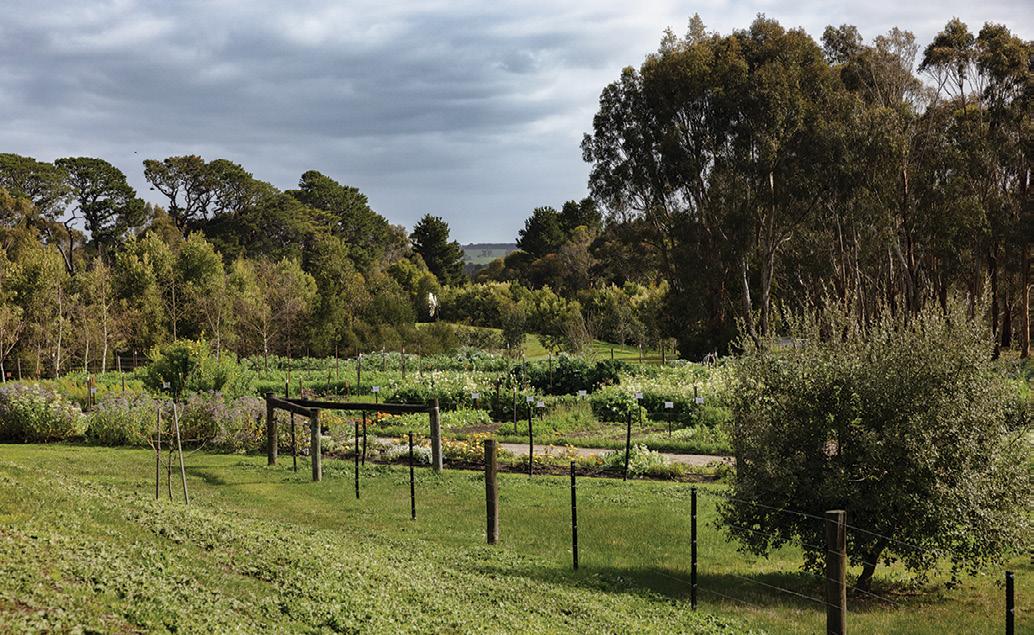
Dining out doesn’t have to end once your meal does just ask the restaurateurs who are getting in on the accommodation game. Independent operators are now integrating stays into their hospitality portfolios, a move which has seen some unique openings. When Julie and Josh Niland secured The Grand National Hotel in Sydney’s Paddington, launching a boutique hotel was always part of the plan. The couple ha s recently begun welcoming guests to a 15-room hotel located two levels above Saint Peter “We are excited about… expanding our expression of hospitality to a wonderful boutique hotel,” said Josh.
Of course, Brae has long been nailing the accommodation arm of its business, which encompasses six suites overlooking the Victorian restaurant’s organic farm. The rooms are carbon-neutral and constructed from recycled materials, reflecting Chef Dan Hunter and the broader team’s commitment to sustainability. Guests can enjoy an optional seasonal supper during their stay a s well as breakfast before checking out. Ultimately, accommodation allows restaurateurs to share an extension of what they call hospitality with guests, which is unique to each operator.

Nose-to-tail is a concept that has long been preached about, however many chefs are hesitant when it comes to putting offal or ‘ inferior cuts’ on the menu. Dishes featuring intestines, brain, feet, and liver are found across the globe and are part of almost every cuisine p âté, gopchang, ox tongue, sweetbread, and Rocky Mountain oysters are just a few examples.
Of course, dishes featuring offal won’t appeal to all guests and are polarising to some, but using as much of an animal as possible plays a critical role in reducing a restaurant’s impact on the environment. It can also be an opportunity for chefs who are unfamiliar with cooking with offal to expand their skill set and challenge themselves to try something different. Heroing offal (and to be clear, offal is very much normal for many people) also comes down to presence and like all things, trickles down the more it is seen. A top-end restaurant in Brisbane recently put a lamb brain burger on the menu, and we’ve seen braised tripe roll out of many Italian kitchens over the years. A modern menu includes offal, so give it a try.
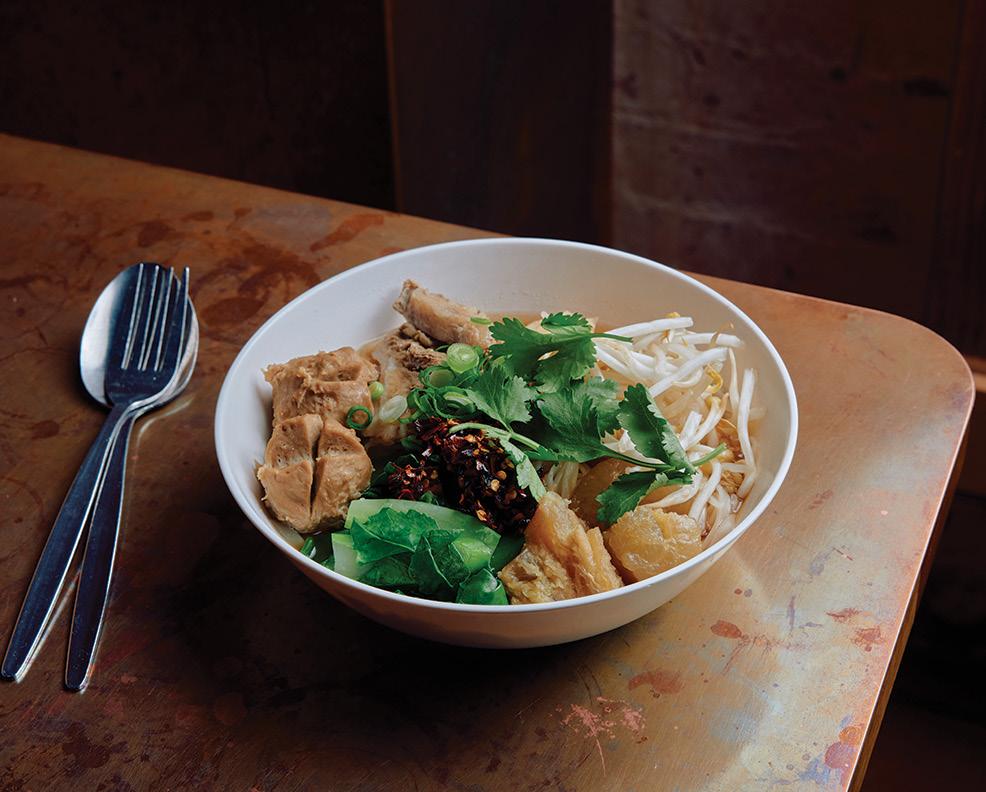
The matcha craze i s still very much peaking, but the proliferation of iced matcha lattes has led to many inferior and watered-down versions. There is absolutely a market for high-quality drinks , but many venues have jumped on the bandwagon without doing the research. There is also now a shortage of the green tea powder due to global demand.
From sourcing poor-quality matcha powders to going heavy-handed on the milk and syrups, there is a lot that can go wrong especially now fruit-flavoured additions such as strawberry, mango, blueberry, and passionfruit are growing in popularity.
Baristas and operators need to trial as many matcha s as possible, which involves testing the powders with different milks and in both hot and cold forms. The differences between poor- and high-quality matcha powders are immediately apparent a dull green colour is an indicator of an inferior product that’s not suitable for beverages. Analysing the grind and structure of the powder as well as the packaging is also essential matcha that is exposed to sunlight or humidity often lose s its original properties and can even develop mould. And of course, equipment and technique cannot be overlooked. It’s well worth investing in training sessions with a tea professional and taking the time to develop a matcha recipe so the ratios are on point.


The cost of wine by the glass has soared in recent years, especially in Australia’s major cities. The average cost of a glass of wine from a restaurant now sits around the $18 mark. Back in 2018, the average price of 750ml of wine in US dollars was $11.40, according to the World Health Organization. Wine is one of the most marked-up products in the hospitality sector, and for good reason there are staff to pay and bills to cover. But choice is the name of the game here, and we’d like to see more venues list affordable by-the-glass options spanning different varieties not just Shiraz and Sauvignon Blanc. For some customers, a $12 glass means they can have two, which equals more money in your pocket.

In
• Celery and yuba salad from Grape Garden Restaurant
• Juicy, rare steak
• Finding good coffee between 2pm and 7pm
• Traditional Greek salad (call me crazy)
• Long dinners with a big crew at Casa Do Benfica
Out
• Low wages
• Wine in ugly, thick-lipped wine glasses (you know who you are)
• Negronis
• Burrata
• Caviar bumps
This year, the industry has seen some major shake ups, especially when it comes to larger groups entering administration. The first to suffer? Suppliers. Smaller businesses are often impacted in a big way, as operators assume they don’t have the manpower to chase up or initiate legal action over unpaid bills. These are the businesses that suffer the most from these losses, which ultimately impact their livelihood s as well as the viability of the companies they worked hard to create. At the end of the day, an unpaid bill is an unpaid bill, but a conversation can go a long way even if it’s just giving a supplier a heads up that you may need an extension. Agreeing on a payment plan is another option, so the supplier can take steps to minimise the impact of the unpaid bill. Communication and transparency is key!

When so many restaurants have tartare on the menu, it instantly goes into the category of ‘dishes I’d like to see less of’.
It’s a classic for a reason, but too much of a good thing is a statement that’s applicable to tartare. The first protein s to hit peak prevalence? Kingfish followed by tuna. Now it’s beef, thanks to the proliferation of European bistros that have continued to mushroom since the start of last year. Don’t get me wrong, there are many excellent tartares available across the country made by restaurants that have had the dish on the menu from day dot.
The Korean variation of yukhoe with nashi pear is one of the most memorable plates I’ve eaten this year and I have eaten my fair share of different tartares during my time as Hospitality ’s editor. But when so many restaurants have the same dish on the menu, it instantly goes into the category of ‘dishes I’d like to see less of’.
It’s been a good stint, but I will be hitting pause on beef tartare until the next protein du jour comes along. I’m predicting the resurgence of crudo in place of tartare. While their commonalities begin and end with the fact that they are made with uncooked proteins, I think more diners will start to lean into fresher, vibrant, and zesty over egg yolk, mustard, and chives. ■







A last-minute change may have ensured Archer Houghton’s win at this year’s Nestlé Golden Chef’s Hat Awards.
WORDS Laura Box
PHOTOGRAPHY Nestlé

WHEN ARCHER HOUGHTON walked onto the stage at Nestlé’s Golden Chef’s Hat Awards, his expression read somewhere between giddiness and disbelief. The 21-year-old Victorian had just found out he was the winner of the 2024 competition, which saw him emerge victorious against 10 other chefs.
It marked the end of months of preparation, which culminated in a trip to Melbourne where the finalists took part in culinary challenges and experiences. On the first day the chefs arrived in the city, they met Delaware North’s Executive Chef Dylan Sanding for lunch and took a tour of the Melbourne Cricket Ground. Afterwards, they took part in a masterclass with Sam Burke from Meat and Livestock Australia (MLA) and attended a Rare Medium Live cocktail party. “Everyone was nervous and anxious, but it was good that we were all together to break the nerves,” says Houghton.
That night, with the competitors sufficiently acquainted (and “all the nerves still very high,” says Houghton), the chefs settled into bed early, brimming with anticipation for the first morning of the competition the next day.
Five of the finalists competed in front of a live audience in purpose-built kitchens at Fine Food Australia on Monday, with the other six cooking on Tuesday. The chefs were tasked with preparing an original three-course menu consisting of a vegetarian entrée, a main course featuring beef, and a hot or cold dessert. Produce was provided from a set pantry, which featured Australian native ingredients and a range of Nestlé Professional products.
“The challenges for everyone were different because we all went through different things,” says Houghton. “The finalists on Monday had no idea what the kitchen looked like — the set up and how the equipment worked, while day two had the stress of [working out] what went wrong [the day before] and trying to figure out how to fix it.”
Houghton competed on Monday but wasn’t fussed about cooking on day one. “We had the benefit of just getting it out of the way and not stressing,” he says. Both days of the competition included an hour to set up, three and a half hours of cooking, and another hour to pack down. Paired with high levels of anxiety and adrenaline, the days were no doubt challenging for competitors. For Houghton, his anxiety was put in a pressure cooker by a last-minute decision to alter the way he prepared his dessert.
“The Saturday night before I started the comp, I changed the timing of my dessert,” he says. An element of the dish was not freezing and defrosting fast enough, meaning he had to push everything forward to begin the dessert earlier, ensuring it had enough time to set. “In my head, I was always 25 or 30 minutes behind.”
Less than 48 hours before the competition began, Houghton completed a practice run in which he was able to get everything finished on time, a feat he achieved again on the day of the competition. “The adrenaline and having the live audience just made me put my head down and get it done,” he says.
Houghton got it done alright, with a menu that Nestlé Executive Chef and Golden Chef judge Elke Travers described



as: “demonstrating great technique across all courses”. The chef received a silver medal for his entrée of mushroom and tofu custard with pickled vegetables and beetroot gazpacho. “I wanted to do something light and delicate,” he says. An ivy-like beetroot tuile adorned the dish, “just to add texture”.
“The menu inspiration came from work,” says Houghton, who is currently an apprentice chef at Mercer’s Restaurant in Eltham, Victoria. “We do a mushroom and tofu custard [at Mercer’s], but I wanted to make it more earthy, so [I added] beetroot and mushrooms. I had no idea what to do for the main, so I got help from my boss.”
“He demonstrated such skill, knowledge, and maturity throughout the competition, and this experience will no doubt take his career to new heights.”
– Elke Travers
For main, Houghton delivered seared rostbiff (a whole rump with the rump cap taken off) served on wilted greens with cottage pie, roasted carrot, and black pepper sauce. Dessert was a strawberry and pink peppercorn mousse with macadamia and coconut crumble, fresh berry salad, and basil foam.
The change in timing may have been the element that made all the difference for Houghton, who received gold medals for his main course as well as his dessert. “He showcased fresh flavours and surprising textural contrasts,” said Travers. “He demonstrated such skill, knowledge and maturity throughout the competition, and this experience will no doubt take his career to new heights.”
Houghton took home a grand prize valued at $10,000, including a 14-day all-expenses-paid trip to the Worldchefs Congress & Expo in Singapore. During his trip, Houghton toured a range of venues and met prominent chefs.
The prize is just one of the many key takeaways from participating in the competition. Houghton says he’s developed essential time-management skills “because every comp takes so much out of you”. He also believes the competition has given him a toolkit to deal with high-pressure, stressful environments as well as the opportunity to network with qualified chefs. The competition gives young chefs strategies to deal with demanding situations, and provides them with a range of industry connections, helping accelerate their careers.
Looking to the future, Houghton is keen to explore his field internationally. “Because I’m so young, I just want to learn as much as I can, so I’m going to most likely travel overseas and figure out exactly where my passion lies,” he says. “I love Japanese cooking, but I also love European techniques… so just marrying those two together.”
For now, it’s back to reality, or as Houghton puts it: “back to the normal chef life, which is nice”. The young chef plans to return to Mercer’s to complete his apprenticeship and continue working with the team he describes as “family”.
Next year will mark the 60th anniversary of the Nestlé Golden Chef’s Hat Awards. Nestlé founded the competition in 1965 with the goal of kickstarting the careers of young chefs in the industry. It gives budding chefs the opportunity to learn from industry leaders, benchmark themselves against their peers, and be challenged in a pressurised environment.
Aspiring competitors between 16 and 24 can apply for next year’s Nestlé Golden Chef’s Hat Award at goldenchefs.com.au
A night of delectable food, flowing wine, and substantial prizes rewarded the up-and-coming chefs.
WORDS
Laura Box
PHOTOGRAPHY Nestlé

ON AN EARLY spring evening, a crowd gathered in Crown’s River Room overlooking the Yarra River to celebrate the achievements of the 2024 Nestlé Golden Chef’s Hat Award finalists. Sparkling wine flowed, and Nobu chefs greeted guests on arrival, making fresh sushi in front of the crowd. There was a sense of excitement and trepidation in the air, with judges and competitors alike dressed in whites embroidered with their names.
The awards night was a breath of fresh air for the finalists, who had spent days in the kitchen at Fine Food Australia battling it out over hot stoves and under intense pressure. The final was the culmination of regional
heats across Australia and New Zealand involving a total of 134 chefs, followed by months of preparation.
After sushi and bubbles, guests enjoyed a three-course menu prepared by Executive Chef Kelly Jackson using Nestlé Professional products and MLA’s Rare Medium beef short rib.
Each of the 11 finalists received a set of medals on the awards night to recognise their efforts. Five other awards were bestowed including Most Creative Use of a Nestlé Product, Maggi Best Savoury Dish, Nestlé Docello Best Dessert Dish, Buondi All Rounder Award, and Most Sustainable Practice Award.





We believe that coffee is all about moments. So we blend our coffee to match those moments, big and small. Crafted for now.



Scan the QR code to find out more



Name: Anshul Gurung, chef de partie, Brewda
Region: South Island, New Zealand
Award: Maggi Best Savoury Dish
Prize: A $2,500 culinary tuition package of the winner’s choice Medals: Silver medals for entrée, main, and dessert
The judges awarded Anshul Gurung Maggi Best Savoury Dish for demonstrating exceptional expertise and flair in his savoury menu.
The judges stated that Gurung’s dish of creamy pea mousse with fresh peas, citrus gel, smoked ricotta, and chilli macadamia captured the vibrancy and freshness of spring. They praised the clever textural contrasts and perfectly balanced sweet and savoury notes.

Name: Deb Ridley, commis chef, Louis in Hotel Realm
Region: Australian Capital Territory
Award: Nestlé Docello Best Dessert Dish
Prize: A $2,500 culinary tuition package of the winner’s choice
Medals: Bronze for entrée, silver for main, and gold for dessert
With the highest points for her desert, which featured Nestle Docello Snowcap White Compound Chocolate, Deb Ridley took out the Nestlé Docello Best Dessert Dish. The judges praised Ridley’s dessert of pumpkin entremets, brown sugar crumble, candied pumpkin, and berry and pumpkin gels for its sophisticated presentation, high level of technical skill, superb flavour, texture, and balance.
“Deb’s creative use of these everyday chef pantry ingredients demonstrates her exceptional skills, technique, and flair in the kitchen,” said Travers. “This dessert is a testament to her ability to think outside the box and create a truly delightful culinary experience.”
“It’s inspiring to see the remarkable achievements of the 2024 finalists, we are proud to support their journey.”

Name: Kyle Victoriano, chef, New Norcia Region: Western Australia Award: Most Sustainable Practice Award Prize: A prize package valued at $1,200, featuring six Koi knives
Medals: Bronze medals for entrée and main, silver for dessert.
To be eligible for this award, entrants needed to submit a short video showcasing innovative sustainable practices or ideas in their workplace.
Kyle Victoriano shot the winning video at his workplace New Norcia Roadhouse. His video explains the sustainable considerations the restaurant has implemented, including using eWater (an organic solution that doesn’t leave a chemical residue) for cleaning, a rainwaterirrigated herb garden, composting practices, and eco packaging.
“As chefs, it’s our responsibility to care for the environment that provides the food we cook,” says Victoriano. “Sustainability isn’t just a practice for today, it’s a commitment for the future and the places we call home.”
Scan QR code to watch the video

Name: Emily Morgan, apprentice chef, Bianca
Region: North Island, New Zealand
Award: Most Creative Use of a Nestlé Product Prize: $1,200 kitchen equipment package of the winner’s choice from event sponsors Solidteknics Medals: Silver for entrée and main, gold for dessert
Emily Morgan won Most Creative Use of a Nestlé Product for her dessert. Morgan delivered a bitter dark chocolate cremeux with raspberry gel and dark chocolate soil, which incorporated Nestlé Continental Bitter Dark Couverture chocolate and Nestlé Royal Kibble Dark Couverture chocolate.
“This well-executed dish was perfectly balanced with both sweet and savoury notes, creating a true chocolate heaven,” said Travers.
“It was as visually stunning as it was delicious.”

Name: Sarah Jones, sous chef, Morphettville Racecourse
Region: South Australia
Award: Buondi All Rounder Award
Prize: A cash prize of $1,000
Medals: Silver for entrée, main, and dessert
Introduced in 2024, the new award recognises a chef who seamlessly blends skill, collaboration, and positivity to elevate the team’s overall performance.
The judges described Sarah Jones as “warm-hearted and always smiling”, saying she “truly embodied the spirit of a team player, with a natural talent for mentoring. Her support of her teammates was evident throughout the competition, offering valuable advice and ideas to help them navigate many challenges.”





Name: Meg Jessup, apprentice chef, Country Club Tasmania Region: Tasmania
Medals: Bronze for entrée, main, and dessert
Name: Amelia Love, apprentice chef, Berry Springs Tavern Region: Northern Territory Medals: Bronze for entrée, main, and dessert
Name: Marione Carmelo, commis chef, Sofitel
Brisbane Central
Region: Queensland metro
Medals: Bronze for entrée, main, and dessert
Name: Amber Vastag, apprentice chef, Bellbird Dining and Bar
Region: New South Wales metro
Medals: Bronze for entrée and main, silver for dessert
Name: Ashleigh Handsaker, qualified chef, Muse Restaurant
Region: New South Wales regional
Medals: Silver for entrée, main, and dessert

Looking for a star performer for your kitchen? Recruit MAGGI Gravy into your team for consistently rich, delicious, meaty gravy that’ll keep your customers coming back for more.







How to make the front-running dish.
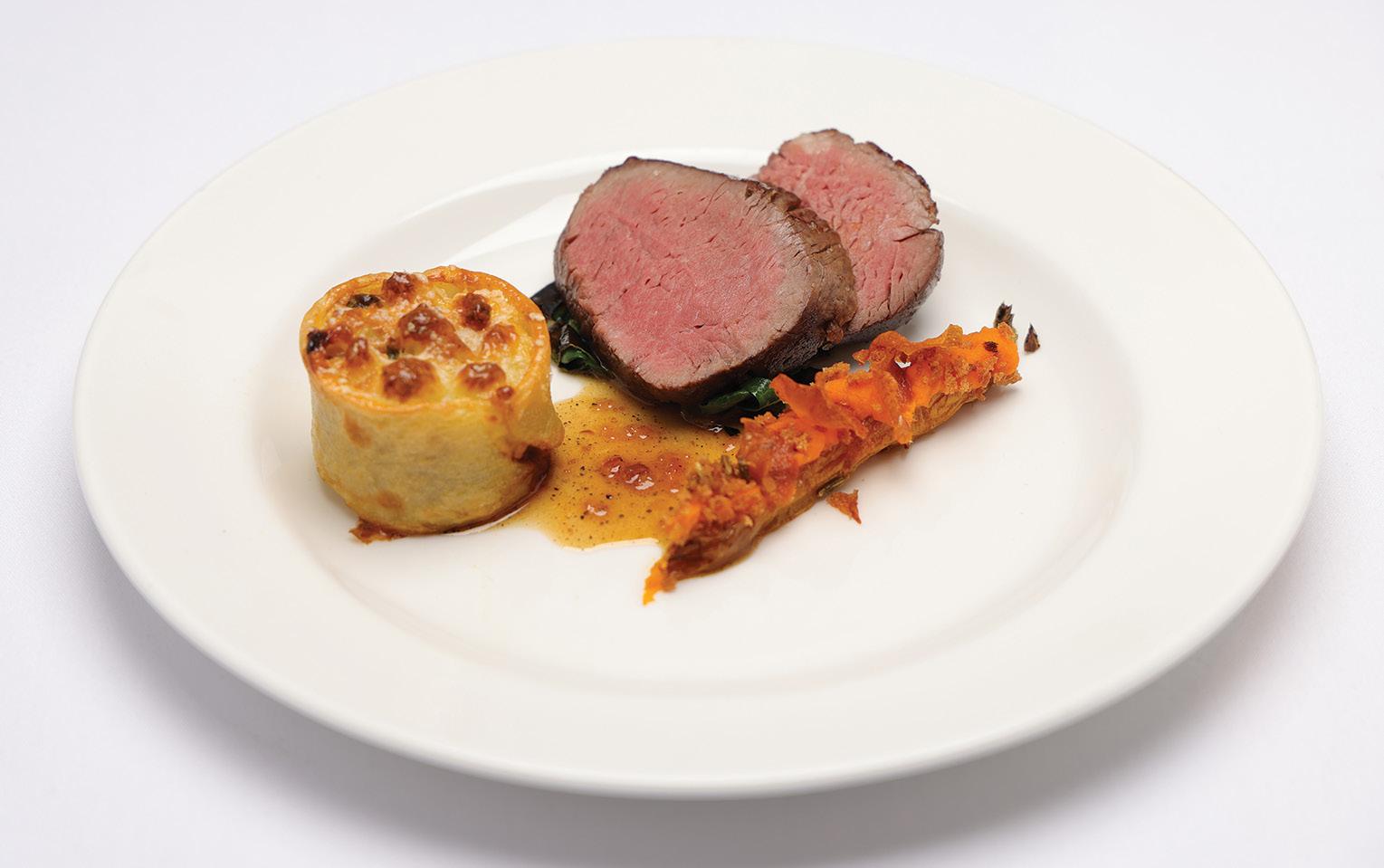
Main: Seared rostbiff with cottage pie, roasted carrots, wilted greens and a black pepper sauce.
Serves 4
Rostbiff: Cling wrap beef (eye side) tightly and poke holes in the cling wrap. Place beef in a vac bag and add garlic, oil, pepper, and thyme. Seal the bag and sous vide in water at 61 degrees Celsius for one hour and 30 minutes. Once cooked, take out of bag and pat dry. Season with salt and fry in a pan until a crust has formed. Add butter, thyme, and garlic to the pan, basting the beef as it cooks. Once cooked, take it off the heat and rest before carving.
Braised rostbiff: Sear off the rostbiff offcuts in a pan with hot oil. Once the beef is golden brown, set it aside. Cook off carrot, onion, and garlic then add tomato paste and red wine and reduce. Add a bay leaf and water. Return beef to the pan and cook on low for one hour. Finish with chopped thyme and peas.
Wilted greens: Heat pan. Add butter, beans, silverbeet, and kale. Cook until wilted.
Potato cup: Peel potatoes and cut two flat sides on each potato. Using a potato cutter, shape the potato into a pie base and then using a knife or a melon baller, cut out the middle of the potato. Place the potato cups in a pot with cold water and salt. Cook until soft but still holding shape.
Mash potato: Place potato offcuts in a pot with cold water and salt. Cook until soft. Pass the potato through a sieve and mix in egg yolk, salt, pepper, and butter. Once the braised rostbiff is finished, fill the potato cup with the braise and pipe the mash potato on top. Grate Manchego over the top and place in the oven to warm the pie. Carrot purée: Roast carrot in the oven until golden. Add carrot to a pot with water then cook until soft. Blend with butter, salt, and pepper until smooth. Place in a piping bag and set aside. Black pepper sauce: Finely dice garlic and ginger and shallow fry until golden brown. Add black pepper and cook until fragrant, then add honey, soy, black vinegar, lemon juice, and sugar. Continue cooking until reduced and thick. Once finished, whisk in butter and set aside.
Carrot: Roast the carrots in the oven until coloured and soft. Meanwhile in a pan with hot oil, fry off the breadcrumbs then add fennel seeds. Once golden brown, strain the crumb and add in chopped thyme. Thinly slice carrots and fry to crisp.
To serve: Place wilted greens in the centre of the plate and top with beef. Place the potato on the plate with the roasted carrot and sauce.
INGREDIENTS
800g rostbiff
2 garlic cloves
20ml olive oil
1 sprig thyme
10 peppercorns
Butter
Thyme
Garlic
Wilted greens
20g green beans
2 leaves silverbeet
2 leaves kale
10g butter
Braised rostbiff
80g rostbiff offcuts
30ml Buitoni Sugo al Pomodoro
50ml red wine
½ carrot
½ onion
1 garlic clove
½ cup water
1 bay leaf
½ sprig of thyme
10g peas
Potato cup
4 medium red potatoes
1 tsp salt
20g Manchego
Mashed potato
Potato offcuts
10g butter
1 egg yolk
Salt
Pepper
Carrot purée
2 carrots
½ cup water
Salt
Pepper
10g butter
Black pepper sauce
3 garlic cloves
30g ginger
1 tbsp black pepper
1 tbsp honey
100ml soy
1 tsp black vinegar
1 tsp lemon juice
1 ½ tbsp sugar
Carro t
½ tsp fennel seeds
¼ cup panko breadcrumbs
1 tsp oil
8 Dutch carrots
Thyme








Take your drinks menu to the next level with our versatile and easy to prepare Nestlé AERO ® and MILKYBAR ® Dessert Mixes.
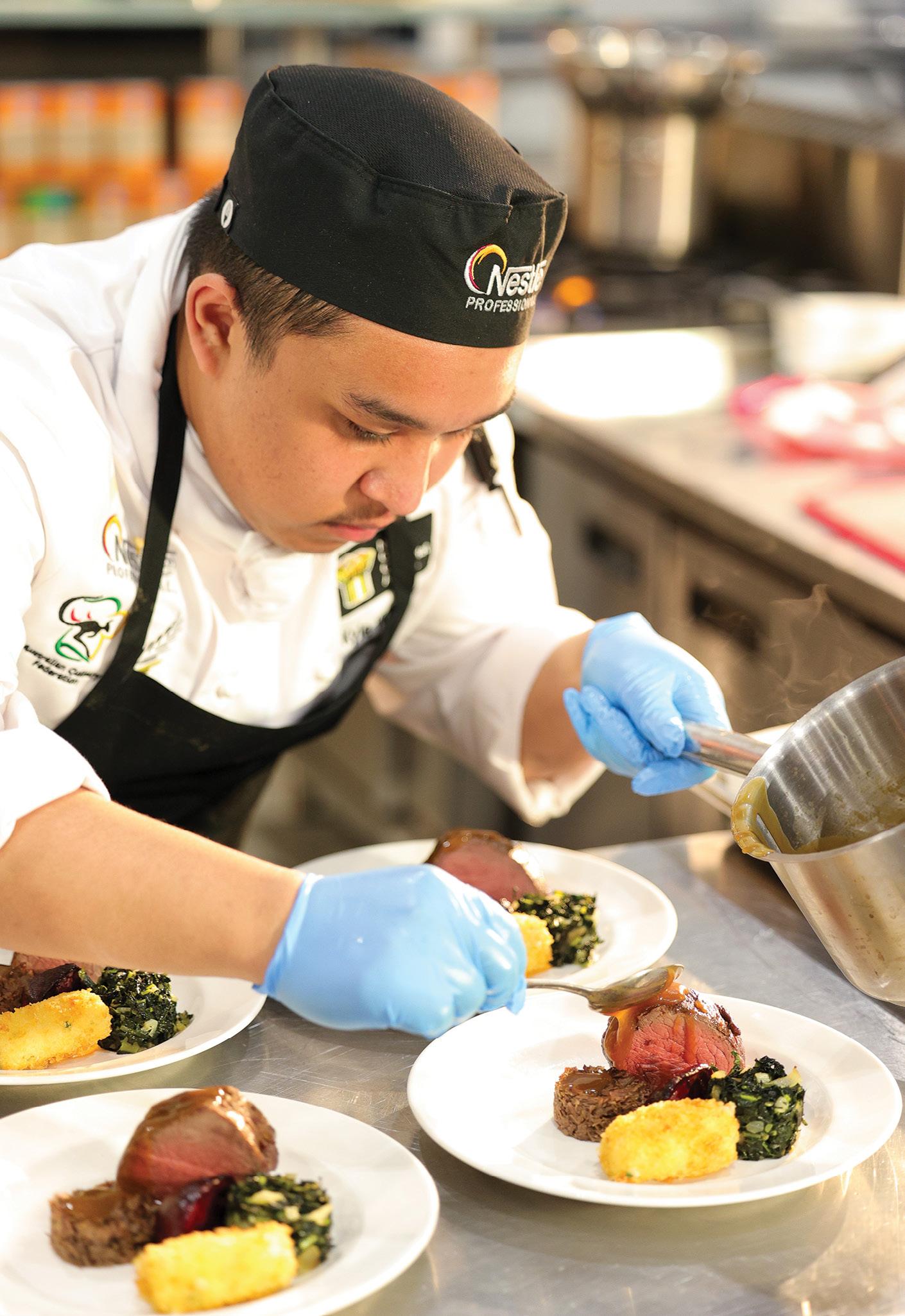
Nestlé Professional Communications & Sustainability Manager Karlie Durrant on the competition’s future.
Why is next year special?
Next year holds special significance as we celebrate the 60th anniversary of the Nestlé Golden Chef ’s Hat competition. The milestone marks six decades of nurturing and showcasing young culinary talent, underscoring our enduring commitment to the future of the foodservice industry by supporting the career development of young chefs. It’s an opportunity to honour our rich history and the thousands of chefs who have been part of this competition, while also looking forward to the innovation and talent of the next generation.
Over 60 years, there have been so many culinary stars which include Telina Menzies, AVC executive chef; Richard Ousby, owner of
Ousby Food; Ben Devlin, owner and executive chef of Pipit Restaurant; and Dylan Sanding, executive chef of the Melbourne Cricket Ground, just to name a few.
What does 60 years represent for the competition and for Nestlé?
For the competition, it signifies a longstanding tradition of providing young chefs with a platform to showcase their skills, gain invaluable experience, and receive mentorship from industry leaders. For Nestlé, it represents our unwavering commitment to supporting the foodservice industry and fostering the growth and development of future culinary professionals.

What can we expect next year?
While specific details are still being finalised, next year’s 60th anniversary celebration will be truly special. We are planning a really unique experience for our Golden Chef of the Year winner, involving travel to Europe and a culinary stage.
What do you want to see from next year’s contestants?
We hope the contestants bring a blend of creativity, passion, and innovation to the competition. We are excited to witness how they incorporate new techniques, sustainable practices, and their own personal signature into their culinary creations. Most importantly, we hope to see them grow both personally and professionally, gaining confidence and honing their skills through this experience.
How do you see the competition progressing in the coming years?
The future of the competition lies in continuing to evolve and adapt to the changing landscape of the culinary world. We will continue to broaden the scope of the competition to ensure that we have a more holistic approach, such as providing young chefs with access to mental wellbeing support together with our partner The Burnt Chef Project.
We will continue to focus on sustainable practices, embrace diversity and inclusion which we do with our partner National Indigenous Culinary Institute (NICI), and provide skill development outside the classroom or their place of work. Our goal is to keep providing a platform that not only showcases talent but also prepares young chefs for the future challenges and opportunities in the foodservice industry. ■






Snippets of wisdom from hospitality experts.

AS 2024 DRAWS to a close, hospitality professionals share their business acumen and tips.
Ash Bailey, owner, Bar Yuki
Create a vibe you want to be a part of. There is so much stress that comes with running a hospitality business, but if you create a space that you genuinely enjoy being in, it will create an environment people love coming back to. There are things you have to be serious about, but try to have fun with all the things you can.
Simon Blacher, creative director, Commune Group
The midweek market has softened over the past 12 months with the demand for weekend trade increasing. Lean into what the market is telling you. Ensure you have a brand-sensitive promotion in place so you can capitalise on the heightened weekend market. Simultaneously, get rid of the fluff on your menu. Simplifying your offer will
streamline your operations and help define your brand from a guest perspective.
Oliver Brown, CEO, Big Easy Group
Time to get ruthless with your numbers! Prices are up across the board: wages, energy, you name it. Don’t just accept it; tender out every cost. Remember, a dollar saved is a dollar earned. Or in hospo, a dollar saved is $10 earned.
Claudio Casoni, owner, Officina Gastronomica Italiana
Energy costs are set to remain high, so invest in efficient equipment and lighting sensors. Switch to biodegradable or reusable containers for takeout and delivery orders. Reducing plastic packaging waste is increasingly essential and shows customers you’re committed to eco-friendly practices.
Kiet Diep, director, Yum Sing House
Always have a clear business plan covering goals, marketing strategies, financials, hiring
processes, training manuals, and standard operating procedures. It sounds obvious, but so many businesses move without purpose and therefore are left without a sense of direction. Failure to plan is a plan to fail.
Amber Doig, head chef, The Butler
People are important. If you invest in staff and take care of the people who take care of your business, everyone comes out on top. My focus is on kitchen culture. Ensuring diversity, tolerance, and respect is paramount as well as helping make our venues great places to work.
Jessica Favaro-Richards, co-owner, Favaro Group
Long-term success is really about creating connections with customers. Take the time to offer personalised experiences. What we are seeing in the Adelaide market is a real desire to connect with operators and to know who is behind the scenes. For us, next year is about getting back on the floor and fostering deep connections with customers.
Sandra Foti, owner, Piccolina Gelateria
The principles of hospitality don’t change from year to year. For us, hospitality is all about honouring our customers, connecting with them, and going above and beyond to make them feel special and valued. Exceptional product is non-negotiable, but the real magic lies in creating moments of pure joy for our community. As we head into 2025, this will continue to be our core focus.
Darren Fraser, general manager, Re’em Yarra Valley
Prioritising culture in our business fosters opportunity, growth, collaboration, innovation , and sustainable practices. A strong culture promotes social wellbeing, attracts talent, and enhances loyalty, aligning employees and customers with shared values. This focus not only fulfills corporate responsibility, but also strengthens our business resilience and long-term success.
Gus Gluck, business operations and beverage manager, Neighbourhood Group
Don’t outsource your social media, even if you don’t know what you are doing. It’s your voice that only you understand. People pay for authenticity. A reminder that ‘going out for a meal’ is an experience and isn’t based on one single component. I’ve eaten good food and had bad experiences, but I’ve had amazing experiences with average food.
Rebecca Grey, co-founder, Luton Lane Wine Bar
The biggest challenge for hospitality at the moment is cost and revenue. The best way to win both challenges is efficiency. Look for ways to focus your staff time on service and sales. Look for products that don’t reduce your quality but reduce your time in preparation and waste.
Scott Huggins, owner and executive chef, Magill Estate Restaurant and Magill Estate Kitchen
The cost of living will see people become even more conscious of how they spend
their money. As a business, you need to keep your percentages in check to ensure you are successful. However, more importantly, you need to keep the product you are offering at a good quality and at a fair price. Don’t rip the customer off to save your bottom line.
Tom Hunter, co-owner and proprietor, Pipi’s Kiosk and Dining Room
Make time for yourself. Work, family, and social activities can all start to overwhelm you to the point where you start thinking that you have no time... Take a few hours a week to be with your thoughts. Having a clear and calm head at work is essential.
Matthew Jenkins, director of people & operations, Applejack Hospitality
Applejack is committed to creating a workplace that instils a sense of purpose, empowering team members to unlock their potential, grow their skills, and build lasting friendships. Our people are at the heart of Applejack, which is why we prioritise treating them with the same care and respect as the customers we serve.
Sunny Lusted, co-owner of Woodcut Restaurant, Marmelo, and Mr Mills
Creating, opening, and operating multiple businesses across two cities requires an enhanced level of support. Surround yourself with passionate, dedicated professionals so you can inspire and support each other. One of the most exciting aspects of my business is finding exceptionally talented hospitality leaders and giving them an opportunity to collaborate at the highest level within our venues.
Telina Menzies, executive chef, Australian Venue Co.
Build a team culture that thrives on collaboration and creativity. When your team is genuinely passionate about hospitality and feels encouraged to contribute, it builds loyalty and sparks fresh ideas like innovative menus or unique guest experiences.


“My tip is that people should learn to take more personal risks so that they reach higher personal rewards.” – Frank Tucker










Matt Moran, co-owner, Aria, Chiswick, North Bondi Fish, et al.
Personalisation and building connections will be everything in 2025. Take the time to get to know guest preferences, whether it’s their favourite drink and seat or a special dietary need. Small details, like remembering their name or a previous visit, make a huge impact. When guests feel seen and valued, they’re more likely to return and it’s these personal touches that help drive a hospitality business.
Jamie Musgrave, executive chef, Restaurant Botanic
Create long-lasting relationships with suppliers who can give you access to niche products. Offering guests something they can’t get elsewhere is a great way to stand out from the crowd. Ensure your team creates a personalised dining experience for each diner... Good service is timeless and the backbone of the industry. It’s hard to compete with, even when the market is tough.
Stephen Nairn, culinary director, LK Hospitality
We have found great success working closely with our suppliers, growers, and purveyors. One supplier had lots of Gamay grapes not suitable for wine. Another grower was playing with the idea of unfiltered verjus. We brought everyone together and ended up with a delicious verjus that now flows through our restaurants. Not only is the solution both costand waste-effective, but we connected three like-minded people.
Justin Newton, director, House Made Hospitality
In a highly competitive market and in an environment of reduced spending, look at your product and service in terms of value. Does a guest walk away from an experience
with you feeling like they got their money’s worth or more? That is what will bring them back, build loyalty, and set you apart.
Sarah Proietti, venue manager and head of people & culture,
Build a team culture based on respect and open communication. Prioritise mentorship, creativity, and networking. Set clear expectations early, as consistent core values drive long-term success. Support wellbeing through tangible actions such as nutritious meals, regular check-ins, public recognition, and constructive private feedback.
Nicole Samodol, owner, Rowlee Wine
Support local growers and producers to sidestep costly imports while strengthening the regional food and wine economy. Emphasising local suppliers can cut down on supply- chain expenses, create fresher menus, and showcase your region’s unique flavours. A commitment to local partnerships reduces food and wine miles and elevates your brand’s community impact.
Dylan Sanding, executive chef, MCG 2025 needs to step beyond just ‘sourcing local’. My tip would be to profile who you rely on for exceptional produce. Collaborate to generate unique offerings, hero what they bring to your plates, and let their brand shine through. A good supplier then becomes a great partner.
Frank Tucker, CEO, Hunter Street Hospitality
My tip is that people should learn to take more personal risks so that they reach higher personal rewards. I look at the next generation as having an unbelievable amount of information and opportunity, and I think they’re going to do well. They just have to trust themselves.
Claire Van Vuuren, co-owner and chef, Bloodwood
Success in 2025 will be about creating a community rather than just offering a service or product. Guests need to have a connection to your venue. They are looking for honesty and authenticity with your staff, your menu, and the overall experience. You will need more than just a great social media strategy to thrive in 2025. ■




We’re welcoming the summer season with a new range of plant-based packaging. Make it easy for your customers to get outside and enjoy the flavours of summer!
Don’t be fooled by the name, the nifty utensil can be used for more than just potatoes.
Also known as a ‘crusher’ or ‘bean masher’
Generally made from stainless steel and less often silicone or wood
Used for preparing a range of soft foods including apple sauce, dips, and soups
The utensil has holes or a rounded zig-zag wire construction

An upright handle connects to a mashing head
Basic wooden versions have been used since the Victorian era
Potatoes release less starch, making for light and fluffy mash
The base of commercial mashers can be up to 80cm
Airex’s innovative and sleek line-up will fit seamlessly into any commercial setting, in retail, commercial kitchens, cafés, in either front or back of house applications.






The Adelaide-based chef on his new book Cooking with Fire.
I AM A cook that never finished high school, however writing kind of comes easily when I’m inspired, in the zone and/or drunk. I generally tend to get comfy, put on music, close the door, procrastinate for several months, and then write in big chunks once I get a publisher email to hurry up.
This book is less biography and more an exploration of regional and suburban Australia and its free public BBQs. We tend to ignore the free facilities provided to us by local councils. So why not write a recipe book that champions them?
Exploring your own backyard is heaps more interesting than getting on a plane to someone else’s...

Being South African, BBQ/braai is genetically in my wheelhouse, and the expectation is that I should have always written a book focusing on that. This seemed like a good opportunity to do that, however I really wanted to attack it from another viewpoint. So instead of churning out a BBQ-inspired book, I wanted to highlight what I thought was cool about Australia and its council BBQs.
South African braai is always cooked on open flames, whereas Australian BBQ
is almost always cooked on gas. However, what makes them the same is the social aspect of cooking outside. It’s more about hanging out and drinking, the food is the bonus.
The recipes in this book are mostly structured so you can prep it all in the backseat of your car or ute. The real value comes from a list of some of the most iconic places to BBQ around Australia, the
choicest locations to road trip to. I really enjoy our carp recipes in this book and our whole pumpkin curry, cooked directly on the embers around an open fire. Our esky punch bowl cocktails are pretty sick, too.
If you can gain one thing from this book, it’s that exploring your own backyard is heaps more interesting than getting on a plane to someone else’s... it’s also way cheaper! ■






